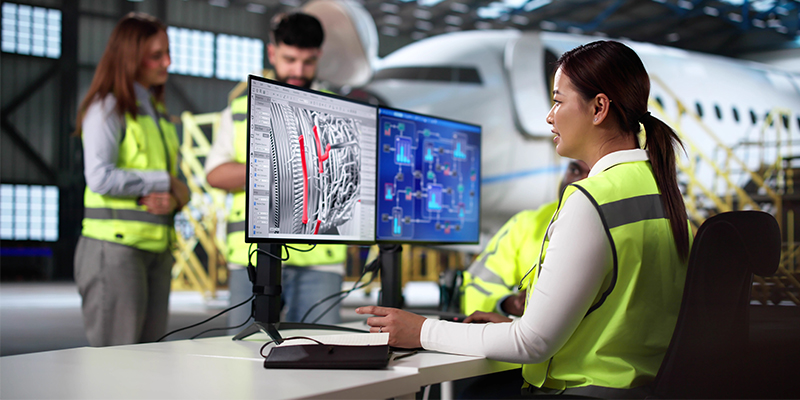By Greg Matter
Across the United States, a manufacturing renaissance is underway. Kick-started by the Bipartisan Infrastructure Law, the CHIPS Act, the Inflation Reduction Act, and a post-pandemic focus on supply chain resilience, the resurgence has spurred new demand for industrial facilities. Most recently, demand has begun to shift from the electric vehicle and clean energy sectors to the aerospace and defense (A&D) sectors receiving stepped-up U.S. Dept. of Defense (DoD) funding.
Geopolitical tensions and the need to modernize military systems are major drivers of the growth in A&D funding and subsequent need for facilities. Related industrial facility demand drivers are artificial intelligence (AI) and AI hardware. Increasingly integrated into military – and civilian – products, semiconductors and other AI hardware are essential not only for processing power, but also for machine learning, autonomous systems, robotics, additive manufacturing, digital twins and connected devices that are common in A&D industries.
Growth of aerospace and defense manufacturing
Government-influenced and innovation-driven, A&D companies have expanded into areas like space exploration, unmanned aircraft and cybersecurity. Led by giants like Boeing and Lockheed Martin, A&D sectors now encompass everything from commercial aircraft, satellites and rockets to munitions, military vehicles and jets, and related components. Use of drone technologies, for instance, has become a common tactic for precision targeting and reducing harm to warfighting personnel.
With federal funding related to electric vehicles in limbo, attention has shifted from Department of Energy-focused projects to those in the DoD realm. Federal funding for aerospace and defense has increased substantially in recent years as the DoD seeks to modernize military systems. Concurrently, geopolitical tensions across Asia, Europe and the Middle East have put defense-related industries back in the spotlight.
Now, aerospace, defense and AI-hardware companies are actively seeking manufacturing facilities and having an impact on the industrial landscape. Most notably, Anduril – a defense technology company – has announced plans for a $1 billion facility in Columbus, Ohio. Joby Aviation is creating a $500 million plant in Dayton, Ohio, to produce electric vertical take-off and landing aircraft. Innovator Boom Supersonic is building a $500 million manufacturing facility in Greensboro, North Carolina, and Terran Orbital is investing in a $300 million plant in Merritt Island, Florida.
A&D supply chain onshoring on the horizon
As the global economic and security landscape has evolved, A&D manufacturers are actively domesticating their supply chains to enhance national security, reduce reliance on foreign suppliers and defend against tariff battles. The DoD’s National Defense Industrial Strategy Implementation Plan for fiscal year 2025 emphasizes reshoring critical parts and materials to minimize risks of sourcing from adversaries, particularly China and Russia.
Given the complexity of A&D supply chains, domesticating suppliers will require significant effort. Aerospace manufacturers rely upon several hundred Tier 1 suppliers and thousands of suppliers across all tiers, according to McKinsey research.
Defense Original Equipment Manufacturers (OEMs) like Lockheed Martin, Boeing, and Northrop Grumman also manage extensive and intricate supply chains involving numerous suppliers across various tiers. Defense technology start-ups particularly rely upon foreign suppliers for critical parts and face difficulties sourcing components domestically.
The impact on real estate
Demand for manufacturing facilities in general has risen by 354% since 2018, according to JLL’s recent Industrial Tenant Demand Study, and is projected to reach 19% of total U.S. industrial property demand this year and 25% by 2028. Federal legislation has sparked significant investments in U.S. manufacturing, creating jobs and expanding supplier networks that have resulted in a combined total of over 131,000 jobs and $387 billion in investment nationwide, as noted in JLL’s U.S. Manufacturing Renaissance report.
In the A&D sector, recent federal funding awards have shifted contracts to markets with strong labor capabilities, such as Dallas-Fort Worth, over traditional hubs such as Seattle and Los Angeles, according to the aforementioned JLL report. However, innovation hubs like Seattle and Los Angeles continue to see strong demand from A&D companies for industrial space.
While DoD contract award volume and venture capital funding vary from year to year, A&D companies have received $5.4 billion in total U.S. investments, creating 20,861 jobs since 2020. Maritime defense enterprises potentially will see a larger share of DoD funding in the next few years, given renewed interest in strengthening U.S. maritime defenses. The proposed SHIPS for America Act, the new White House shipbuilding office, and April maritime executive order all aim to boost American commercial and naval ship construction. Despite slowing venture capital funding in recent years, aerospace and defense continue to see record growth in contracting, underscoring these sectors’ strategic importance and economic impact globally. Property investors can expect to see continuing demand for manufacturing facilities as A&D companies expand their domestic operations and supply chains.








